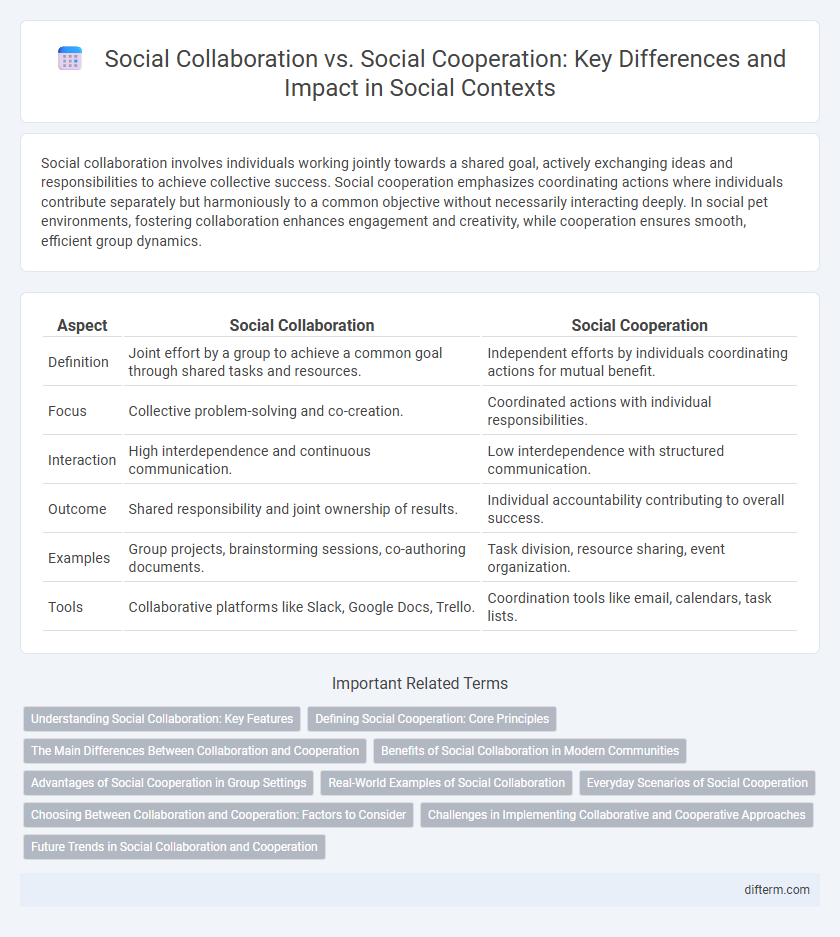Social collaboration involves individuals working jointly towards a shared goal, actively exchanging ideas and responsibilities to achieve collective success. Social cooperation emphasizes coordinating actions where individuals contribute separately but harmoniously to a common objective without necessarily interacting deeply. In social pet environments, fostering collaboration enhances engagement and creativity, while cooperation ensures smooth, efficient group dynamics.
Table of Comparison
| Aspect | Social Collaboration | Social Cooperation |
|---|---|---|
| Definition | Joint effort by a group to achieve a common goal through shared tasks and resources. | Independent efforts by individuals coordinating actions for mutual benefit. |
| Focus | Collective problem-solving and co-creation. | Coordinated actions with individual responsibilities. |
| Interaction | High interdependence and continuous communication. | Low interdependence with structured communication. |
| Outcome | Shared responsibility and joint ownership of results. | Individual accountability contributing to overall success. |
| Examples | Group projects, brainstorming sessions, co-authoring documents. | Task division, resource sharing, event organization. |
| Tools | Collaborative platforms like Slack, Google Docs, Trello. | Coordination tools like email, calendars, task lists. |
Understanding Social Collaboration: Key Features
Social collaboration emphasizes interactive engagement and joint problem-solving among diverse participants, leveraging shared goals and collective knowledge to drive innovation. It involves dynamic communication channels, mutual accountability, and the integration of individual expertise to achieve complex outcomes beyond mere task completion. Unlike social cooperation, which centers on divided responsibilities and parallel efforts, social collaboration fosters deep interdependence and continuous feedback loops for enhanced group performance.
Defining Social Cooperation: Core Principles
Social cooperation centers on mutual assistance and collective problem-solving, emphasizing shared goals and interdependent roles within a community or organization. Core principles include trust, reciprocity, and coordinated actions that enhance group cohesion and productivity. Effective social cooperation requires transparent communication and a commitment to common interests, distinguishing it from more informal or loosely structured social collaboration.
The Main Differences Between Collaboration and Cooperation
Social collaboration involves individuals working jointly towards a shared goal, emphasizing collective problem-solving and idea exchange, whereas social cooperation entails individuals contributing separately to a common task without necessarily interacting deeply. Collaboration prioritizes mutual engagement and coordinated efforts, fostering innovation and synergy within teams. Cooperation focuses on completing parts of a task independently, relying on division of labor rather than continuous interaction.
Benefits of Social Collaboration in Modern Communities
Social collaboration fosters enhanced innovation and problem-solving by leveraging diverse perspectives within modern communities. It promotes stronger relationships and trust, which lead to higher engagement and collective ownership of projects. These benefits result in more resilient and adaptable communities capable of addressing complex social challenges effectively.
Advantages of Social Cooperation in Group Settings
Social cooperation in group settings enhances collective problem-solving by fostering shared responsibility and unified goal achievement. It builds trust and strengthens interpersonal relationships, leading to increased group cohesion and sustained collaboration. These advantages result in higher productivity and more innovative outcomes compared to social collaboration.
Real-World Examples of Social Collaboration
Social collaboration involves individuals working together interactively to achieve shared goals, exemplified by open-source software projects like Linux, where global contributors continuously develop and improve the platform. Social cooperation, by contrast, typically refers to members contributing separately but toward a common purpose, seen in community blood donation drives where participants independently donate for a collective benefit. Real-world examples of social collaboration highlight dynamic interactions and joint problem-solving, as demonstrated by disaster response teams coordinating resources and expertise in real time during crises.
Everyday Scenarios of Social Cooperation
Social cooperation in everyday scenarios involves joint efforts where individuals work toward shared goals, such as community clean-ups or neighborhood watch programs, enhancing collective well-being. This form of collaboration emphasizes coordination and mutual support, often relying on trust and communication within groups to achieve common outcomes. Unlike broader social collaboration that can include diverse and complex interactions, social cooperation is rooted in direct, purposeful actions that improve daily social environments.
Choosing Between Collaboration and Cooperation: Factors to Consider
Social collaboration involves interactive engagement where participants actively share ideas and responsibilities to achieve a common goal, fostering innovation and collective problem-solving. Social cooperation, by contrast, emphasizes coordinated efforts with clearly defined individual roles, prioritizing efficiency and task completion. When choosing between collaboration and cooperation, factors such as the complexity of the task, desired level of creativity, and the need for flexibility versus structure should guide decision-making.
Challenges in Implementing Collaborative and Cooperative Approaches
Implementing social collaboration and cooperation faces significant challenges including misaligned goals, communication barriers, and varying levels of participant engagement. Difficulty in establishing trust and managing conflicts often hinder seamless interaction among diverse stakeholders in both collaborative projects and cooperative frameworks. Overcoming these challenges requires clear role definitions, effective conflict resolution mechanisms, and consistent engagement strategies to foster productive social partnerships.
Future Trends in Social Collaboration and Cooperation
Future trends in social collaboration emphasize the integration of AI-powered platforms and real-time communication tools that enhance collective intelligence and innovation. Advances in blockchain technology are expected to facilitate more transparent and secure cooperation among decentralized teams. Increasing adoption of virtual and augmented reality will create immersive environments that foster deeper social interaction and teamwork across global networks.
social collaboration vs social cooperation Infographic

 difterm.com
difterm.com